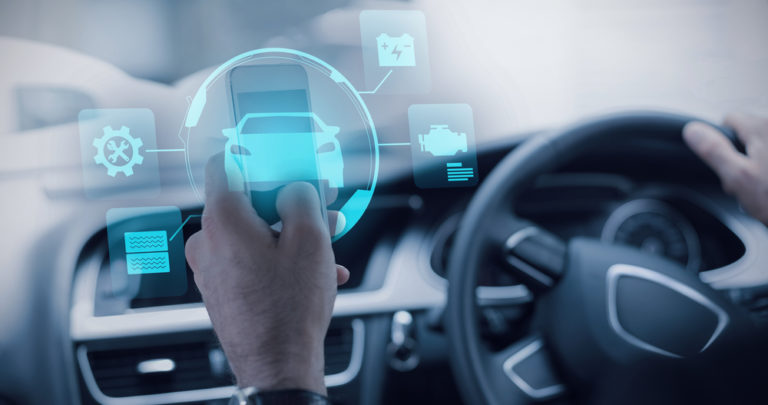
If a car buyer from the 1950s had the ability to travel forward in time to make their purchase, they might not have been too shocked by what they saw in the 1970s, 80s, 90s or even 2000s. Even though form factors have changed, safety has improved and top speeds are higher, the humble car essentially remained the same for decades. But if our time travelling car buyer emerged today, there would be several surprises in store for them.
That’s because over the last few years, a revolution in driving has begun. Connected technology, already responsible for such disruption in much of our everyday lives, is reshaping the automotive world in front of our eyes. So much so that global consultancy PwC forecasts that annual sales of connected car technologies will triple to €122.6 billion by 2021. It’s a topic we’re examining in detail over on /review, our customer magazine, but here’s a few modern car-buying questions our time traveler might not be prepared for.
What technology do you need inside?
For a long time, advances in car technology were evolutionary – radios to cassettes to CDs, automatic windows and so on. But the ability to transmit and receive data has changed the game, and is really the cornerstone of today’s connected car.
Traditional SIM cards weren’t built to withstand the harsh environment of a car engine, so it wasn’t until the relatively recent arrival of the embedded SIM (eSIM) that car companies could really push forward. Now it’s not uncommon for huge, tablet like touch screens to dominate the cabin – providing access to maps with live traffic and smart routing, streaming any kind of entertainment to passengers’ personal screens and all forms of electronic communication. Technology like this will allow for increased convenience for drivers, such as being directed automatically to a free parking space, or automated financial transactions when joining a toll road or stopping to buy more fuel.
Can we access your driving data?
Connecting cars to the cloud means that data can be transmitted from the car in real time. In the last few years, insurers have been using smartphone apps as a way to track a driver’s behavior on the road (average speed, acceleration etc.) and adjust premiums accordingly.
As cars become increasingly connected, that data can come directly from the vehicle – opening up a new era in customer care. Manufacturers like Tesla are using millions of miles of customer data to both improve their understanding of how the cars perform over time, but also to provide tailored, personalized ongoing customer service based on individual habits.
Other user data could also be accessed by the car to provide other personalized services. Passengers could for example, automatically access music playlists or subscriptions to streaming services, to provide personalized entertainment on the road. Cars may also be able to communicate with other smart technology you have at home – for example, turning off the alarm system when you enter the driveway.
Do you even need one in the age of Uber?
Disruption isn’t just coming from manufacturers like Tesla, but services that didn’t exist before. While taxis have of course been around for a long time, services like Uber and Lyft have quickly made true on-demand transportation a reality. Now, in almost any city in the world, a driver can come to your location within a few minutes of a tap on the smartphone.
These ‘sharing economy’ start-ups have been so successful that consumers can legitimately question whether they even need to own a car at all anymore. But an even bigger disruption to the automotive market is already underway…
Do you want it to drive itself?
We’re not quite there yet, but the days when fully autonomous vehicles are a common sight on our roads are not too far away. Trials are underway among traditional manufacturers as well as technology giants like Apple and Google, to test cars and delivery trucks that can safely navigate themselves from A to B. Tesla’s much lauded Autopilot system is already active, though it still requires drivers to have their hands on the wheel just in case.
Fully autonomous cars require seamless Vehicle-to-Vehicle (V2V) communication to enable them to broadcast their position and speed in order to avoid collisions, while on-board radar, laser and optical sensors allow them to react quickly (potentially much faster than the average human) to obstacles or sudden changes in the road ahead (e.g. a pedestrian walking into the road). Cars will also need to communicate with other road infrastructure such as traffic signals. This is known as V2X communication, and will rely heavily on 5G technologies which are still being developed. The key advantages of 5G networks are that they won’t be as subject to congestion when multiple users log on at once, and it has the potential to connect an almost infinite number of low-bandwidth objects, such as thousands of cars moving on connected highways.
Aside from ongoing development of 5G, there are still many other challenges to overcome before fully autonomous driving can become mainstream – notably security. Issues including intercepting data, tracking car use or even hacking into cars to take control or steal them, need to be evaluated and overcome to make people confident in their safety. Cyber security is not a traditional strength of traditional car manufacturers, so finding the right technology partners who can secure the car and the cloud for its entire lifetime is crucial.
But if driverless technology can be achieved at scale, the next shift in driving habits will be unlike anything we’ve seen before, with knock on effects for other industries. Accidents should be fewer, congestion will be eased and cars will be able to optimize their use to cause least environmental harm. And for passengers – imagine passing the time on a long journey by sitting in a mobile cinema, or conducting a business meeting in a mobile boardroom. If running a business from a vehicle became possible, what does that mean for real estate companies selling office space? If self-driving cars were plentiful enough for you to call one on demand and be in it within minutes, would you still choose to buy a car? If that were a reality, would you be interested in ‘subscribing’ to driving services from a certain manufacturer? The questions, and possibilities, are almost endless.
For much more on all the above, read our full article: Road to revolution: from connected cars to new mobility. What else do you expect from the future of cars? Share your own thoughts in the comments below.
About Gemalto
Gemalto (Euronext NL0000400653 GTO) is the global leader in digital security, with 2015 annual revenues of €3.1 billion and customers in over 180 countries. We bring trust to an increasingly connected world.
Our technologies and services enable businesses and governments to authenticate identities and protect data so they stay safe and enable services in personal devices, connected objects, the cloud and in between.
Gemalto’s solutions are at the heart of modern life, from payment to enterprise security and the internet of things. We authenticate people, transactions and objects, encrypt data and create value for software – enabling our clients to deliver secure digital services for billions of individuals and things.
Our 14,000+ employees operate out of 118 offices, 45 personalization and data centers, and 27 research and software development centers located in 49 countries.
For more information visit www.gemalto.com, or follow @gemalto on Twitter.



